#Mobility Management Entity
Text
Virtualized Evolved Packet Core Market Projected to Reach $19.87 Billion by 2031
According to the latest publication from Meticulous Research®, the virtualized evolved packet core (vEPC) market is projected to reach $19.87 billion by 2031, growing at a CAGR of 19.3% from 2024 to 2031. This growth is driven by the significant increase in mobile data traffic volumes and the rising demand for high-speed data services. However, data security risks associated with vEPC infrastructure pose challenges to market growth.
#Virtualized Evolved Packet Core Market#VEPC Market#Mobility Management Entity#Home Subscriber Server#Packet Data Network Gateway#Policy and Charging Rules Function#Mobile Private Network & Mobile Virtual Network Operator (MPN & MVNO)#Long-term Evolution & Voice over Long-term Evolution (LTE & VoLTE)#Telecom Operators#Internet of Things & Machine to Machine
0 notes
Text
Worldbuilding: Questions to Consider
Government & authority:
Types of government: What type of government exists (monarchy, democracy, theocracy, etc.)? Is it centralised or decentralised?
Leadership: Who holds power and how is it acquired (inheritance, election, divine right, conquest)?
Law enforcement: Who enforces the laws (military, police, magical entities)?
Legal system: How are laws made, interpreted, and enforced? Are there courts, judges, or councils?
Laws:
Criminal laws: What constitutes a crime? What are the punishments?
Civil laws: How are disputes between individuals resolved?
Cultural norms: How do customs and traditions influence the laws?
Magic/supernatural: Are there laws governing the use of magic or interaction with supernatural beings?
Social structure:
Class/status: How is society divided (nobility, commoners, slaves)? Are there caste systems or social mobility?
Rights & freedoms: What rights do individuals have (speech, religion, property)?
Discrimination: Are there laws that protect or discriminate against certain groups (race, gender, species, culture)?
Economy & trade:
Currency: What is used as currency? Is it standardised?
Trade laws: Are there regulations on trade, tariffs, or embargoes?
Property laws: How is ownership determined and transferred? Are there inheritance laws?
Religion/belief systems:
Religious authority: What role does religion play in governance? Are religious leaders also political leaders?
Freedom of religion: Are citizens free to practice different religions? If not, which are taboo?
Holy laws: Are there laws based on religious texts or teachings?
Military & defense:
Standing army: Is there a professional military or a militia? Who serves, and how are they recruited?
War & peace: What are the laws regarding war, peace treaties, and diplomacy?
Weapons: Are there restrictions or laws regarding weapons for civilians? What is used as a weapon? Who has access to them?
Technology & magic:
Technological advancements: How advanced is the technology (medieval, steampunk, futuristic, etc.)?
Magical laws: Are there regulations on the use of magic, magical creatures, or artifacts?
Innovation & research: How are inventors and researchers treated? Are there laws protecting intellectual property?
Environmental/resource management:
Natural resources: How are resources like water, minerals, and forests managed and protected, if at all?
Environmental laws: Are there protections for the environment? How are they enforced? Are there consequences for violations?
Cultural & ethical considerations:
Cultural diversity: How does the law accommodate or suppress cultural diversity?
Ethics: What are the ethical foundations of the laws? Are there philosophical or moral principles that underpin them?
Traditions vs. change: Does the society balance tradition with progress? How?
Happy writing ❤
Previous | Next
#writeblr#writing#writing tips#writing help#writing resources#creative writing#worldbuilding#fantasy worldbuilding#fantasy writing#fantasy world#deception-united
1K notes
·
View notes
Text
Ghost blobs lead someone to Danny
(There is a part 2 now)
Batman froze at the floating blob, nearly the same color of lauzus waters and glowed even brighter. It seemed to notice him and ziped over to him at an alarming speed. Batman tensed ready to strike. But the thing just hovered in front of him and humming? It sounded desperate and worried, despite sound completely inhuman. His lack of response on seemed to increase the noise it made now make odd movements in one direction.
Before he could blink suddenly he was swarmed with the things. Some started pushing at his back and face. Others grabbed at his cape and tried tugging him forward. All of them humming the same desperate tune. Against his better judgement, a feeling in his chest told him to follow. "Alright" He whispered to the odd blobs. "Lead the way." Several bolted away as he chased behind them. A few stayed with him flying next to him or tucked into his cape.
He followed them over buildings until they reached a warehouse district. He was lead to an area designated for demolition. Finally the blobs float to the ground stoping at a warehouse with a door left ajar.
When Batman pushed the doors open he saw nothing, he stood still for a moment. He nearly thought it was a trap. Before the familiar gentle push urged him on. The ones leading him before flew behind a pile of trash and just barely he could see a faint glow behind it.
When Batman walked behind the trash pile, he froze. A dozen more blobs were there all crowding around a dimly glowing child. The white haired child was curled up and seemed to be bleeding lauzrus green. Batman rushed over and grabbed the child's wrist to feel for a pulse. His heart lurched when he found one, and it lurched again when the boy moved. He whimpered and weakly tried pulling away.
He sprang into action and pulled the boy to himself. He grabbed his bandages and gently uncurled the boy to see his wounds. He froze again at the Y-shaped cut on his chest and the countless other cuts left on him. "Please- please stop." Batman snapped back to when the boy spoke. "It's alright, you're safe now." He said softly, he wrapped the boy up as best he could. "What's your name?" He asked as he gently picked the boy up.
The boy was humming like the blobs he realized, it was far weaker like a buzzing in his hands. "Danny" The boy replied, Batman nearly didn't hear him. "I'll keep you safe Danny, I promise." At that Danny seemed to relax and melt into him. Batman called the Batmobile.
The blobs followed them outside a few seemed to fly away before coming back. Like they were patrolling the area. Others were comforting Danny, rubbing up against him or humming a different sound possibly to reassure him. "What are they?" Batman asks, hoping to get some information before the boy could pass out. "Blob ghosts." He muttered.
"Ghosts?"
"It's what I am, but I'm really bad at it" Danny mumbled the last part to himself but Batman caught it. A ghost entity? It would explain the lack of a pulse and even the wounds. A ghost haunted with his own autoposy scars. Before he could ask more the bat mobile stopped in front of them.
Batman hopped inside and gently place Danny in the passenger seat, buckling him in. The blob ghosts followed tucking into the back in a quick flurry. And like that Batman set off. He called Alfred. "Alfred, prepare the medbay. I have a severely injured unknown."
"Right away"
Batman barely managed to keep the boy awake all the way to the Batcave. Batman tries to ignore Alfred's shocked face as he sees Danny and the swarm of blob ghosts that follow them. "You didn't say they were this unknown."
"Danny says that they are 'blob ghosts' and claims he is a ghost as well. But that he is bad at it some how." Batman explained as they rushed to the medbay. When Batman set the boy down a white ring of light appeared around the boy it split and passed over him. They were left with a very human looking boy who was now bleeding red, mixing in with the green.
He and Alfred shared a look of shock. Before having to push the feeling away to help the boy.
#dcxdp#dp x dc#dpxdc#dc x dp#Batman is totally calling the nearest magic man he can to come help him#How Danny got there is up to interpretation#Mine is Danny managed to escape to the ghost zone being led by blob ghosts before they all get swept up in a random portal#And the blob ghost went to find help#Batman was the only one that didn't run away#And he had an aura of protection and something that felt close enough to ghost core#They were basically screaming at him to come help their boy#I'd imagine that Jason could understand them a bit better.#He'd probably get swarmed by them too
3K notes
·
View notes
Text
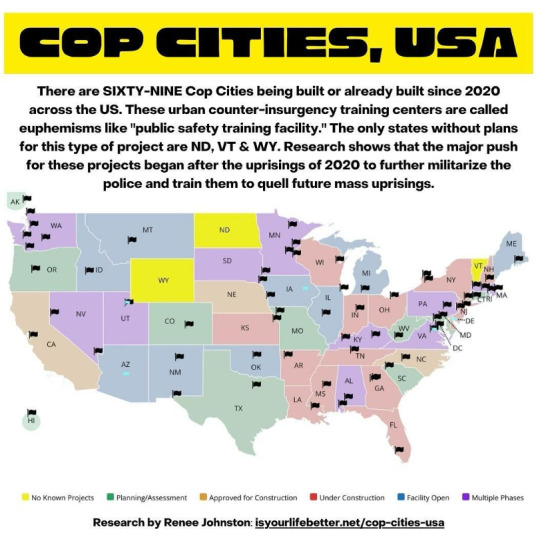
The Stop Cop City movement has sought to prevent the expropriation of part of the Welaunee Forest for the development of an 85-acre police mega training center: a model town to prepare the state’s repressive arms for the urban warfare that will ensue when the contradictions of their exploitation and extraction become uncontainable, as they did in 2020 after the APD murdered Rayshard Brooks.
That murder, and all those that came before, were the lodestars of the Black-led movement during the George Floyd uprisings; their demands were no less than the dismantlement of the entire carceral system. Unable to effectively manage or quell the popular street movements, the Atlanta Police Foundation set out to consolidate and expand their capabilities for surveillance, repression, imprisonment, armed violence, and forced disappearance. One result is Cop City, which has been racked by militant sabotage, land occupation, arson, and popular mobilizations, in an attempt to end the construction and return Atlanta to its people.
As the Atlanta Police Foundation was unable to contain the 2020 Black rebellion, so too have they been unable to quell the resistance against Cop City. The press reports that the project is hemorrhaging money and is mired in delays and difficulties. For their part, the city, the state, and the federal government, have in turn employed every tool in their power to destroy the movement. Last week, the Georgia State Senate passed a bill to effectively criminalize bail funds in the state; RICO charges have been contorted to target networks of support and care that surround the fighters; and last January, APD assassinated the comrade Tortuguita in cold blood while they rested in their tent in the forest. It is clear that Stop Cop City represents one of the conjunctural spear tips for expanding the existing systems of counterinsurgency that span Africa, Asia, and the Arab world.
Today the system’s belly rests atop Gaza, whose rumblings shake the earth upon which we walk. Through its Georgia International Law Enforcement Exchange (GILEE) program, the APD has sent hundreds of police to train with the Zionist occupation forces. And in October 2023, after Tufan al-Aqsa, the Atlanta Police Department engaged in hostage training inside abandoned hotels, putatively intended to “defeat Hamas,” in an advancement of tactics for the targeting of Black people.
With every such expansion, the ability of counterinsurgency doctrines to counteract people’s liberation struggles grows. The purpose of counterinsurgency is to marshal state and para-state power into political, social, economic, psychological, and military warfare to overwhelm both militants and the popular cradle—the people—who support them. Its aim is to render us hopeless; to isolate and dispossess us and to break our will to resist it by any and all means necessary. This will continue apace, unless we fight to end it.
Stop Cop City remains undeterred: on Friday, an APD cop car was burnt overnight in response to the police operation on February 8; yesterday, two trucks and trailers loaded with lumber were burnt to the ground. An anonymous statement claiming credit for the former, stated: “We wish to dispel any notion that people will take this latest wave of repression lying down, or that arresting alleged arsonists will deter future arsons.”
As the U.S. government and Zionist entity set their sights on the Palestinian people sheltering in Rafah, as they continue their relentless genocide of our people in Khan Younis, Jabalia, Shuja’iyya, and Gaza City, the Stop Cop City movement has clearly articulated its solidarity with the Palestinian struggle. They have done so with consistency and discipline, and we have heard them. Our vision of freedom in this life and the next requires us to confront and challenge the entangled forces of oppression in Palestine and in Turtle Island, and to identify the sites of tension upon which these systems distill their forces. This week, as with the last three years, the forest defenders have presented us one such crucible.
(11 Feb 24)
National Lawyers Guild, Stop All Cop Cities: Lessons For a National Struggle (video, 1 hr 45 min)
1K notes
·
View notes
Text
✎ masterlist part 2 . . .
yandere villain x gn reader x yandere hero part 2
yandere general
yandere celebrity
yandere side character
yandere octoman
yandere drider
yandere teacher
yandere janitor
yandere sugar baby
yandere sugar daddy
yandere slasher
yandere fiancé
yandere auctioneer
yandere vampire
yandere milf
yandere cosplayer
yandere hero
yandere ex crush
yandere monster
yandere rich girl
yandere boss
yandere blade oneshot (hsr)
yandere tomie
yandere platonic grandpa
yandere sahsrau
yandere academic rival
yandere female best friend
yandere twins
yandere food delivery driver
yandere immortal
yandere god
yandere sleepy bf
yandere imaginary friend
yandere yoga teacher
yandere wedding planner
yandere burger chef entity
yandere figure skater
yandere cannibal
yandere dad's loser bestie
yandere french fry chef entity
yandere platonic clown
yandere catboy
yandere loveless loser
various yandere mr loverman drabble
yandere detective
yandere mean boy
cute classmate
soft girl
soft boy
yandere female lead
yandere camboy
yandere lucky fella
yandere rich guy
platonic yandere himbo
yandere mobile phone plan shop worker
yandere younger brother's best friend
yandere killer harem
yandere cringe loser harem
yandere one eyed monster
yandere prison warden
yandere rental boyfriend
yandere tsundere
yandere foreign exchange student masterlist
yandere masseur
yandere teddy bear
yandere "good boy"
yandere genius
yandere shortie arsonist
yandere golden retriever
yandere death god and yandere life god
blue eyed yandere
yandere infected harem
yandere sweetheart
yandere manager
yandere influencer
yandere first date
yandere singer
yandere enemy
rewind?
out of pocket yandere
yandere argenti (hsr)
yandere fwb
yandere seller
yandere t-rex hybrid
yandere lifeguard
yandere sunday (hsr)
yandere bounty hunter
yandere jingyuan (hsr)
yandere co actor
yandere criminal
yandere polar bear hybrid
yandere ghost husband
yandere gym rat
939 notes
·
View notes
Text
In case you missed - GREAT Neopets News!
I didn't see anybody talking about the news here, so I thought that I could share a summary.
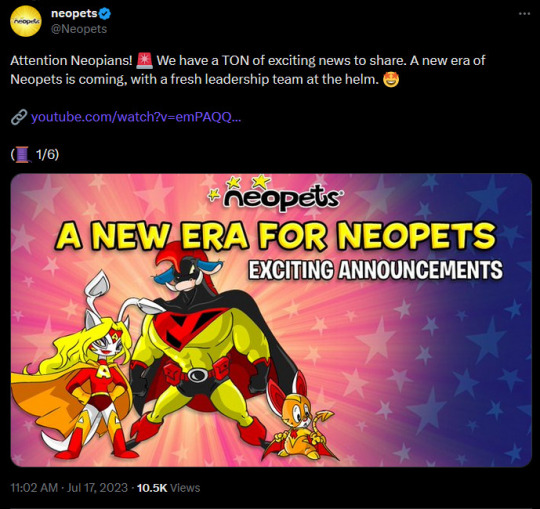
The Neopets Team announced today that they're under new management. They're no longer affiliated with Jumpstart (which announced their closure back in June) or their parent company NetDragon.
In their blog post in the official Neopets Medium page, they confirm that they are now an independent company:
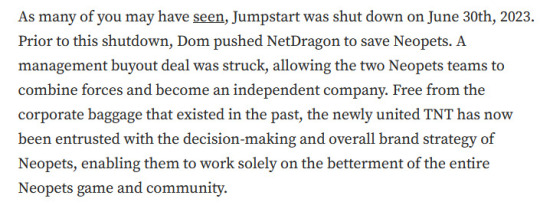
(Dominc Law, worked for NetDragon and was an old school Neopets player. He put together a team to work on saving the brand.)
Also in that blog post the team talks about how they are well aware of the problems the site has been through in the last decade, they acknowledge the lack of resources which resulted in the Neopets website being left broken.
Going ahead, they are going to focus on community requests, such as speeding up the process of Flash Games conversion, clearing up the page conversion backlog, bug fixes, mobile compatibility issues and improving customer support.
Most importantly, in my opinion, they clear up that they WILL NOT go forward with any Metaverse bullshit, and will instead work on creating a game that feels like Neopets:

At this point, they have secured $4M in funding from various (unnamed) investors with additional funding from the management buyout. For the first time in forever, it looks like TNT has the resources they need to move the brand forward. In the blog post, they mention they have already hired developers and artists to work on the fixes the site needs.
From what it looks like, the game will be a mobile social life-simulation, parallel to the current website. We don’t have to worry that neopets.com will be replaced by a mobile app.
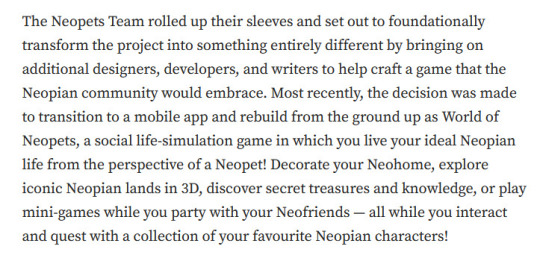
As of now, they have announced:
A brand new plot, scheduled for early 2024
A 2 million(!) NeoCash giveaway
More transparency with monthly updates from the team, scheduled AMAs
Neopets will be under the control of a new, unified entity: World of Neopia, Inc - the website will remain the same (neopets.com)
A Brand Ambassador Program
No longer going forward with NFT/Metaverse stuff
At the end, they published a FAQ with some answers that I found to be good and very interesting:
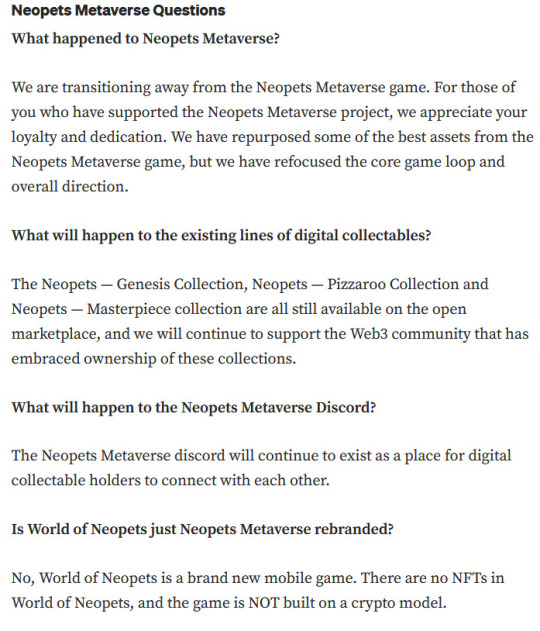
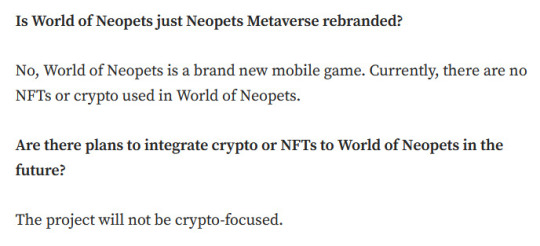
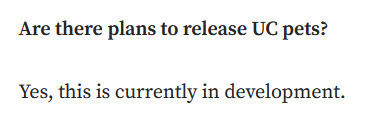
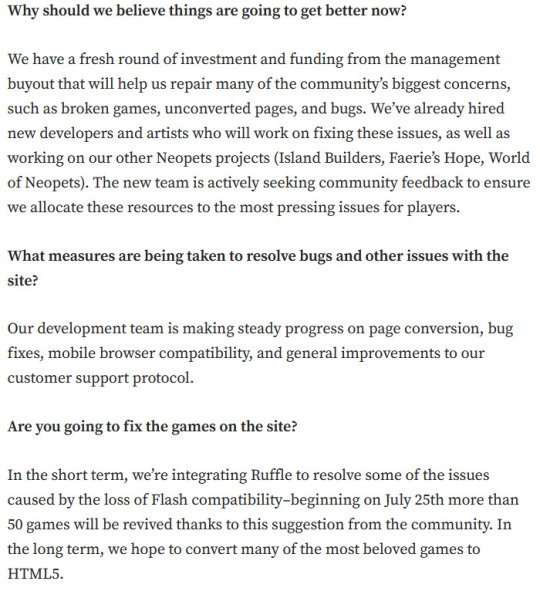
You can read the entire blog post here.
Or watch the YouTube announcement (which is way shorter):
youtube
#neopets#putting my journo degree to a good use i think#i am in no way affiliated with TNT or jumpstart or netdragon etc#i'm just really really happy#things look bright for once and i'd like to share the news#i know some people might be skeptical but i'd like to be optimistic for once and trust the team#most of them nowadays are old players if i'm not mistaken#i don't think they like to see the website in shambles as it was#also really goddamn glad they're moving away from crypto shit#i appreciate the transparency#also be nice to me i'm shy#Youtube#i admit i got a little lazy by the end#nostalgia#y2k nostalgia#kidcore#will these tags even show up
587 notes
·
View notes
Text
A summary I saw posted on discord! I did not write this ❤️
ok here's my effort at collating all the high-level updates.
Neopets is now a standalone entity after JS's closure.
New head of said entity is Dominic Law (staff name probably Altador...that's what he goes by in NMC server), who previously headed NMC and saved Neopets through a "management buyout deal"
New TNT has raised $4M from external investors to be used for rebuilding the brand/site.
Plan to incorporate Ruffle to save Flash content. 50(!) games will be returning via Ruffle on July 25th!
Plan to launch new mobile app "World of Neopia", "a social life-simulation game in which you live your ideal Neopian life from the perspective of a Neopet"
Plan to increase communication. "releasing monthly updates, hosting regularly scheduled AMAs, and launch an exciting new brand ambassador program"
New unified home page launching July 20
Plan to relaunch Island Builders
Plan for "a virtual concert"
Plan for a new plot (called "The Void Within" per the youtube video)
Launch 2M NC giveaway, which ends Aug 6
Neopets Metaverse has been cancelled. Some assets will be used for World of Neopia, but world of Neopia will have no crypto/NFT elements. Collectibles continue to exist and can be traded on secondary markets but have no utility.
#im plagiarizing sorry#cautiously optimistic i guess? i am nervous about the new owner's association with crypto however#neopets
387 notes
·
View notes
Note
hi! i went to look for physical descriptions of the ROs but the link isn’t working. is there an alternative link?
No but I can help you here!
Pariah
Pariah is 5’5” with an athletic build to their body, mostly honed from all of the physical exertion their night job requires. Most often they wear riding gear (leather jacket, cargo pants, biker boots; basically attire appropriate for someone who rides high-speeds on a motorcycle) with a black motorcycle helmet that has red lights within it. The helmet is modified to allow Pariah to discern things at night, and also to withstand Pariah’s own powered abilities. Pariah also carries two sickles strapped at their waist. Their powered ability is shadow manipulation.
Without the helmet, they have short cut curly brown hair, tanned skin, brown eyes, and a scar on their chin. Here’s an excellent visual of them drawn by the talented @phanosis !
Vasilisa
Vasilisa stands at about 5’11” with another athletic build to her body, again honed by her career as a detective for the C.A.P.D. She usually wears a white dress shirt rolled up at the sleeves, black jeans, timberland boots (closest I can describe them) and on occasion will have a black blazer on. Very often seen with a coffee in hand because her sleep schedule is as atrocious as anyone’s in Attollo. Her powered ability is emotion manipulation.
Vasilisa has blonde hair she keeps tied back, pale skin, and blue eyes. She has a beauty spot under her one eye. Here’s an excellent visual of her drawn by the talented @exotic-inquiry !
Suha
Suha stands at 5’8” with a softer build. Her employment as a judge for the Crowes Court and her role in her own fashion business often keeps her quite preoccupied and on the go. Suha is a Muslim, and therefore wears a hijab. Her role in fashion means she dresses incredibly well, often preferring higher-brand clothes lines that are both comfortable and befitting of her personality. She prefers lighter colored clothes, as it contrasts the gloom of Attollo, even though her personality itself is quite serious. Suha’s powered ability is botakinesis, or plant manipulation.
Suha wears cat-eyed glasses and has dark skin and brown eyes. Here’s a stunning drawing of her done by the talented @artsyaprilmr !
Operator
Operator stands at 5’7” and has a very lean build coming from his amazing ability to forget to eat half the time. He’s rarely seen without his black face mask and blue tech glasses, which enable him to see the ongoing of the city even when mobile. He usually wears a black turtleneck and black jeans, as well as sneakers that should really be changed in at some point. He does wear gloves as well when outside of his dwelling in the Under City. Operator’s powered ability is tech manipulation… among other things.
He has auburn curly hair and blue eyes beneath the glasses, as well as pale skin. @exotic-inquiry also did some lovely art of him (he is a little guy) !
Sysba
Because Sysba is gender selectable, their appearance does tend to change depending on which you select, although not by much. Overall, though, Sysba is a very flamboyant being that dresses in a way they feel expresses themself best. They stand at 6’ all forms, with a toned form they somehow managed to retain despite their disastrous eating habits. They prefer colours like red, black, or white for what they wear, and they prefer fabrics like satin, velvet, or silk. Sysba often wears heels for the benefit of standing an extra few inches above everyone else. They also indulge with a lot of jewellery, including necklaces, earrings, nose rings, etc. Because they are an entity, their powers extend far beyond what most do; shape shifting, manipulation, and power absorption are a few of their abilities. If they could get out of Attollo, they would be travelling quite swiftly too.
In all forms, their hair is black, their eyes are black, and their skin is a very sickly pale color. In male form, Sysba has short cut hair, in female form it comes in the form of a bob cut, and in the non binary form it’s short cut as well. The very talented @retconomics has art of them here, @phanosis was generous enough to draw them in their more ‘natural’ form, and @redjack even kindly made a 3d model!
DW
Standing at 6’4” with a more built tone, one could say, due to his line of work (you don’t run a criminal organization without some intimidation on the side). Dreamwalker dresses very business-like in all aspects of his arrival, including in the dreams (although he did play dress up for those because it was fun for him). He prefers dark dress shirts, dress pants, and well-polished dress shoes. He wears a signet ring on his right hand. His powered ability includes dream manipulation and an ability to directly harm a sleeping individual through their dream, as seen with MC. He usually warps his features in dreams to make him indiscernible. On occasion, he wears a red scarf when not wearing a high collared shirt.
Dreamwalker has dark brown, almost black hair with a slight curl to it. His eyes are a glowing gold with no discernible pupil unless you’re very close, in which case you will see it as a darker yellow color. He has a notable scar on his neck from a knife wound, and dark skin. The talented @bleruh drew art of him here (check out their operator as well!), as did @retconomics here and @/kill-a13 here among many others :)
84 notes
·
View notes
Photo

The Saxon Circles within the Holy Roman Empire
by hunmapper
The Saxon Circle (Sächsischer Reichskreis) was one of the ten imperial circles (Reichskreise) established in the Holy Roman Empire during the late Middle Ages and early modern period. These circles were administrative and defensive entities formed to organize and manage the empire's territories for mutual defense and governance. Here are some key points about the Saxon Circle: Formation: The Saxon Circle was officially established in 1500 as part of the Imperial Reform initiated by Emperor Maximilian I. It comprised territories largely belonging to the House of Wettin, including the Electorate of Saxony and other lands ruled by branches of the Wettin family. Composition: The Saxon Circle consisted of territories primarily located in the present-day states of Saxony, Thuringia, and parts of Brandenburg and Lower Saxony. It included the Electorate of Saxony, the Duchy of Saxe-Wittenberg, the Duchy of Saxe-Lauenburg, the Margraviate of Meissen, and various smaller principalities and counties. Administrative Functions: The primary purpose of the Saxon Circle was to coordinate defense, maintain peace, and provide mutual assistance among its member states. It also served administrative functions such as taxation, recruitment of troops, and representation in the Imperial Diet (Reichstag). Military Contributions: Each member of the Saxon Circle was expected to provide troops and financial support for the defense of the empire. The circle's military forces were mobilized in times of conflict to defend against external threats or to enforce imperial authority within the region. Diet Representation: The Saxon Circle had representation in the Imperial Diet, where its members could voice their concerns and participate in the decision-making processes of the empire. This representation allowed the circle to assert its interests and influence imperial policies.
39 notes
·
View notes
Note
great info on the mayors / political leaders of New York - on the anti side, how about the absolute worst and most destructive , regressive, or otherwise harmful in its history?
This one is mostly covered by my first post about NYC mayors, where I discussed the mayors from Lindsay to the present.
However, I can talk about earlier mayors, even though most of them were bland non-entities. One major exception to this rule was Fernando Wood.

If there was one consistent theme of Wood's career - other than fraud (Wood stole from his bank and his own brother-in-law) and corruption - it was racism and violence.
From the very beginning of Wood's political career, he distinguished himself as the most pro-slavery man in New York Democratic politics, seeking the patronage of figures like John C. Calhoun and James Buchanan. When he shifted from Congress to mayoral politics, Wood went back and forth on what variety of pro-slavery politics he preferred (variously backing Douglas' popular sovereignty position and Buchanan's anti-Douglas position), but was a consistent enemy of John Van Buren's Free Soil Democrats, "Black Republicans," and abolitionism as a concept. Nevertheless, he managed to win election in 1854 with a bare third of the total vote.
Unlike more pliable Tammany mayors, Wood believed in "one-man rule" rather than collective pursuit of power, particularly when it came to direct mayoral control of the police force. While claiming to stand for home rule, democratic accountability, and efficiency, in reality Fernando sought to remove any commissioners on the police board who stood between him and turning the Municipal Police into his personal army. In the 1856 election, Wood gave the police the day off so that the Dead Rabbits gang could engage in street violence, physical intimidation of voters and poll workers, and theft of ballot boxes. Evidently Wood needed the help, because he won with a tiny plurality of the vote and ran well behind the Democratic ticket.
Wood managed to skate from any indictment from Election Day violence, but he had gone too far politically. Tammany broke with Wood, barring him from the building and promoting his political opponents to Federal patronage positions. The Republican-controlled state legislature enacted a new Municipal Charter that ordered a new election for 1857 and transferred control over public works to state commissioners appointed by the governor, and then a Metropolitan Police Act that abolished Wood's Municipal Police and replaced them with a new force under state commissioners.
Wood refused to accept the Metropolitan Police Act or the Municipal Charter as law, ordered his Municipal Police to physically remove state commissioners from government buildings, and when the new Metropolitan Police attempted to arrest him for selling the office of Street Commissioner for $50,000, Wood mobilized the Municipal Police against the "Black Republicans," leading to the "Great Police Riot" in which the two police forces met in open combat on the steps of City Hall. 53 people were injured, the state militia had to be called out to disperse the Municipal Police, and Wood was arrested (and then promptly released by a friendly judge).

New York City's gangs, with Wood's allies the Dead Rabbits very much in the lead, realized that with the city's two police forces at war (Wood had directed the Municipal Police to stop the Metropolitan Police from carrying out arrests, leading to frequent skirmishes), there was no state monopoly on violence to restrain them.
Amid a rising crime wave, the Dead Rabbits Riot broke out on July 4th - in which the Five Points gangs under the leadership of the Dead Rabbits invaded the Bowery and went to war with both the Bowery gangs and the Metropolitan Police. At its height, the riot involved 800-1,000 armed men and women who responded to police charges by building barrricades. Once again, the state militia had to be called out to quell the violence (at least 8 people killed and about 100 injured), although fighting would continue for another week. Ultimately, the courts ruled against Wood and the Municipal Police were disbanded.
In the election that year, Wood ran on a pro-slavery platform that praised the Dred Scott decision and Buchanan's pro-slavery policy in Bleeding Kansas, while attacking Republican efforts to expand voting rights to black New Yorkers. This race-baiting failed to distract voters from the violence and corruption of the Wood Administration, to say nothing of the Panic of 1857 which had sent unemployment in the city skyrocketing. To get rid of Wood, Tammany formed a fusion ticket with the Republicans and Know-Nothings that narrowly defeated the incumbent mayor.
Learning nothing from his defeat, Wood blamed the loss on a shadowy cabal of "Black Republicans" who had supposedly infiltrated Tammany Hall and formed his own rival Democratic machine out of Mozart Hall. In 1859, Wood once again used armed violence, this time to try to seize control of the State Democratic Convention from Tammany delegates. When this didn't work, Wood once again turned to racism in his campaign to get back into the mayoralty, running on a pro-slavery, anti-John Brown, and anti-abolition platform. He just barely managed to pull out another tiny plurality victory with only 38% of the total vote.
In his next term, Wood crossed the line from mere bigotry to open treason, calling for New York City to secede from both New York state and the United States (both controlled by "Black Republican" abolitionists, according to Wood) so that it could trade freely with the Confederacy. In 1861, Wood came in third place for re-election, finishing only a thousand votes behind both the Republican and the Tammany Democrat.
Despite (or arguably because of) his vocal pro-Confederacy stance and his supporters having caused the 1863 Draft Riots, Wood became the leader of the so-called "Peace" Democratic faction against the War Democrats. Lest you think that Wood was motivated by his abbhorence of war, Wood made the reasons for his opposition clear when he pushed for constitutional amendments to protect slavery, attacked War Democrats as "a white man's face on the body of a negro," and led the Congressional opposition to the passage of the 13th Amendment. In 1868, Wood was censured by Congress for his verbal attacks on the Reconstruction Acts. This censure accomplished nothing, and Wood continued his Congressional career unabated, which culminated in becoming Chairman of the Ways and Means Committee following the end of Reconstruction.
Wood had the reverse Midas touch of turning everything he touched to shit, such that even the few good things he supported - like home rule for New York City and public works jobs for the unemployed - became tainted by association with his violence and corruption. As far as I'm concerned, they should have done him like they did Vallandigham.
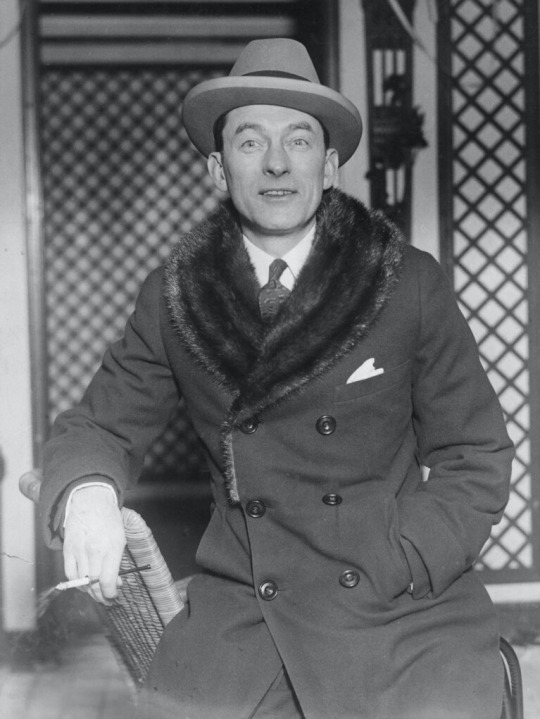
Compared to Wood, the faults of every other NYC mayor seem like the most minor of venal sins.
"Gentleman" Jimmy Walker was corrupt as fuck - supporting his lavish lifestyle by taking bribes from anyone with a pulse, selling the services of the NYPD to the mob, getting in bed with Arnold Rothstein, and perhaps having been connected to the murder of a whistleblower on police corruption and the disappearance of a New York Supreme Court judge - but he was also part of the progressive wing of Tammany Hall and a talented administrator (albeit one who only worked from 3-5 so as not to interfere with his more important time with showgirls, nightclubs, speakeasies, and boxing matches). He supported social welfare policies, opposed the KKK, built municipal waterworks and subway lines (albeit through corrupt contracts), and created the Sanitation and Hospitals Departments.
Similarly, William O'Dwyer was a typical Tammany politician who oversaw a massive police corruption scandal in Brooklyn, and ultimately had to flee to Mexico to avoid investigations from the Justice Department and the Brooklyn DA into his ties with organized crime, but he was in most other respects a typical if unremarkable mid-century NYC Mayor.
Shouldn't have raised the subway fare to ten cents, tho.
#history#u.s history#nyc history#nyc mayor#fernando wood#may he burn in hell#jimmy walker#william o'dwyer#tammany hall#political machines#urban politics
28 notes
·
View notes
Text
Hamas’s Oct. 7 attack on Israel has initiated an unpredictable chain of events, and it is too early to determine how the attack might shape the future course of the struggle for Palestinian liberation. The vast destruction of the Gaza Strip and the horrifying loss of civilian life are a painful blow to Palestinians, reminiscent of the Nakba of 1948. Yet, simultaneously, the illusion that the Palestinian question can be swept aside while Israeli apartheid persists has been shattered, and Palestine is back at the top of the global agenda—with growing recognition that it must be addressed, even if the brutal massacres of Oct. 7 have polarized the debate around it.
Since 2007, Hamas’s presence in the occupied territories has been restricted to the Gaza Strip, where the movement has been effectively contained through the use of a hermetic blockade that collectively imprisoned Gaza’s 2.3 million Palestinians. In its containment, Hamas was stuck in what I have termed a “violent equilibrium,” whereby military force emerged as a means for negotiating concessions between Hamas and Israel. The former uses missiles and other tactics to compel Israel to ease restrictions on the blockade, while the latter responds with overwhelming force to build deterrence and secure “calm” in the areas around the Gaza Strip. Through this violence, both entities operated within a framework whereby Hamas could maintain its role as a governing authority in Gaza even under a blockade that enacts daily structural violence against Palestinians.
Beginning in 2018, Hamas began experimenting with different means of changing this equilibrium. One was through its decision to allow for popular protests against Israel’s domination to take place. The Great March of Return in 2018 was one of the most extensive examples of Palestinian popular mobilization. The protest emerged as a civil society-led effort that was given permission, supported, and ultimately managed by a committee comprising the various political parties in Gaza, including Hamas. As a governing authority, Hamas provided much of the infrastructure necessary for the mobilization, such as buses to transport activists. This was a stark departure from the means with which Hamas traditionally challenged the blockade.
Another shift in the equilibrium came a few years later, in 2021, when Hamas leveraged its military arsenal to retaliate against Israeli aggression in Jerusalem. In the lead-up to Hamas’s rocket fire, Israel had been actively working to expel families in the Sheikh Jarrah neighborhood from their homes to make room for Jewish settlers. This initiated widespread mobilization of Palestinians across the land of historic Palestine. The Israeli state responded with force and mass arrests against protests that were peaceful and included prayers around Al-Aqsa Mosque. Israel’s efforts to disrupt the protests and push forward with its colonization of East Jerusalem triggered Hamas to respond with rocket fire.
These examples demonstrate efforts by Hamas to go on the offensive and expand its resistance to encompass demands that extend beyond the lifting of the blockade. Such positioning implies an objective to act as a military power that comes to the defense of Palestinians against Israeli colonial violence beyond the Gaza Strip. Underpinning these tactics was a clear strategic shift by the movement to transition away from acquiescence to its containment to a more explicit challenge of Israeli domination—and thereby overturn the equilibrium that had become entrenched over the course of 16 years.
This shift is in keeping with Hamas’s historical evolution as a movement that has relied on both armed and unarmed resistance, in ebbs and flows, to challenge Israel’s occupation and to push for core demands of the Palestinian struggle, including the right of return, which was central in the 2018 protests. (Hamas’s history is replete with examples in which it read the political context around it and, on the level of the movement’s leadership, altered the strategic direction of the organization, with clear instructions for the military wing to either escalate or de-escalate.)
The recent shift to all-out violence is also in keeping with the movement’s understanding of the role of armed resistance as a negotiating tactic—one that the movement has historically relied on to force concessions from Israel.
The Oct. 7 attack can be seen as the next logical step for a movement chafing against its containment. Some analysts have described Hamas’s move as suicidal, given Israel’s reaction, or irresponsible, given the death toll it has led to among Palestinians. Whether or not either of these characterizations is accurate depends on an analysis of what options Hamas had and on how the dust settles. There is no doubt, however, that the attack itself was a decisive rupture—one that is, in retrospect, clearly the culmination of all the changes that the movement had been experimenting with.
The strategic shift entailed moving from the limited use of rocket fire to negotiate with Israel into a full-throttled military offensive aimed at disrupting its containment, specifically, and the Israeli assumption that it could maintain an apartheid system with impunity.
There is little doubt that the bloody Oct. 7 attack exceeded Hamas’s expectations and that the scale of the massacres in Israel has galvanized Israeli and international opinion in ways that Hamas may not have entirely anticipated. Any significant military operation that Hamas conducted with any degree of success—targeting military bases near the Gaza-Israel fence area and securing a significant number of Israeli combatants—would have similarly shattered the paradigm of the blockade and elicited a devastating Israeli response.
Yet the killing of civilians on this scale—whether or not Hamas’s leadership had actively pushed and prepared for this level of bloodshed—has galvanized a ferocious Israeli response in Gaza, enabled by the carte blanche granted to the Israeli government by most Western leaders. Some scholars of genocide have argued that the Israeli campaign amounts to ethnic cleansing and intent to commit genocide.
It is counterfactual to argue whether or not these responses would have taken place had no civilians been killed or kidnapped. Either way, Hamas’s military offensive and the mass violence that followed have irreversibly shaped the nature of the response against Palestinians in Gaza.
From a strictly military-strategic perspective, prior to the attack the only option other than the use of force available to Hamas was to remain constricted within the framework of the blockade, while Israeli settlers expanded their rampaging violence in the West Bank, Israeli politicians disrupted the status quo around Jerusalem’s Haram al-Sharif/Temple Mount complex, and Israel got rewarded with U.S. visa waiver programs and regional normalization agreements.
Within this climate, the options Hamas had were to acquiesce to the continued assumption that Palestinians had been effectively defeated and to remain confined and strangulated within their various Bantustans—parcels of discontiguous land resembling the apartheid-era South African “homelands” of the same name, where many disenfranchised urban Black people were relocated and governed by supposedly independent local puppet regimes while a white supremacist government continued to exert military control.
The choice, as Hamas saw it, was between dying a slow death—as many in Gaza say—and fundamentally disrupting the entire equation.
It is certainly the case that cornering Hamas—and Palestinians more broadly—into a situation whereby only a powerful military attack of this form emerges as the preferred option for the movement could have been avoided. Even prior to Hamas’s containment, and specifically since the Second Intifada, there were many opportunities for diplomatic and political engagement with it.
Hamas had de facto acquiesced between 2005 and 2007 to a political program that may, if leveraged correctly, have led to the creation of a Palestinian state alongside Israel and the dismantling of the occupation. This was a position that the movement put forward as part of its election victory in 2006 and subsequent entry into the Palestinian Authority. Later, this position was formalized in 2017 in the movement’s amended charter, which called for the creation of a Palestinian state on the 1967 line, without offering formal recognition to the state of Israel.
The Israeli and American refusal to engage with any of the movement’s political concessions since then, while Israel was consistently given a free pass to maintain its violent occupation and ongoing colonization of Palestinian land, undermined any faith Hamas may have harbored regarding the international community’s interest in holding Israel to account or enabling Palestinians to establish a state on a portion of historic Palestine.
Much has been written on the lost opportunities of dealing with Hamas diplomatically. The events that followed the movement’s democratic election in 2006 were premised on a refusal to engage with Hamas’s political platform, with Israel and the U.S. government preferring to pursue regime change and to deal with Hamas militarily, choosing to limit their engagement on the Palestinian file with the PA.
Since then, Israel has supported and enabled Hamas to exist as a governing authority while simultaneously demonizing the movement as a terrorist organization, a paradox that enabled the state to justify the collective punishment inherent in the blockade of the Gaza Strip. This was explicitly the chosen strategy of successive governments under Benjamin Netanyahu, who openly spoke about the benefits to Israel of pursuing a “separation policy” between the West Bank and the Gaza Strip as a means of undermining prospects for Palestinian statehood.
In the absence of any real diplomatic prospects for Hamas, its choices were either slow strangulation as the governing authority of the Gaza Strip, while Israel became ingratiated with Arab regimes that had all but abandoned the Palestinian cause, or a decisive blow that could fundamentally disrupt the assumption that Palestinians were defeated and subservient and that Israel could maintain its apartheid regime cost-free.
That Hamas opted for the latter suggests that it is behaving strategically and remains committed to the belief that it is playing a long game. By this logic, even if Hamas’s military wing were entirely destroyed or expelled, the movement has already secured a victory in revealing the weakness and fragility of Israel’s military, which can be exploited in the future through a reconstituted Hamas or through another future military formation equally committed to armed resistance as a means of liberation. In other words, the disruption itself becomes a space for alternative possibilities to emerge, whereas, prior to that, there was only the calcified certainty of continued Palestinian oppression.
This belief in a long game means that regardless of what happens in the short- to medium-term future, even with the horrifying loss of civilian life in Gaza, Hamas has disrupted not only the structure of its containment but the entire notion that Palestinians can be siloed into Bantustans and forgotten without Israelis incurring any cost. That disruption is existential for Israel, and, supported by Western allies, the state believes that the only way to survive this blow is through decimating Hamas.
Israel will fail—and is already failing—in attaining that objective. Regardless of how the battles against Hamas in Gaza unfold now, the movement can already claim to have emerged victorious in the long term because it irreversibly shattered the false sense of security Israelis had cloaked themselves in, despite all attempts to present Israel as invincible and impenetrable.
But even in the immediate battle taking place in Gaza now, prospects for an Israeli victory are slim. As in any asymmetric struggle, the guerrilla fighters merely have to not lose to emerge victorious, whereas the powerful state will lose if it does not achieve its overarching goals. And the goal of decimating Hamas as a movement is as vague as it is unachievable. For one thing, the movement is much bigger than its military wing. It is a movement with a vast social infrastructure, connected to many Palestinians who are unaffiliated with either the movement’s political or military platforms.
At its core, Hamas is an Islamist movement that has its roots in the regional branches of the Muslim Brotherhood. It is connected to health care infrastructure and educational facilities and charities. If, by decimating Hamas, Western and Israeli leaders are calling for the killing of any Palestinian who espouses any form of Islamist ideology, then that is nothing less than a genocidal call against the Palestinian people, and it should be understood as such.
If, however, the goal is to destroy the movement’s military infrastructure, then this goal is likely to fail in one key way. The breaking apart of Hamas’s military wing will set the stage for the emergence of other forms of organized resistance—whether within Hamas’s ideological garb or otherwise—that are similarly committed to the use of armed force against Israel.
History has already taught us this much. Hamas emerged in 1987 from the embers of the PLO’s historic concession, whereby throughout the late 1970s and early 1980s the PLO shifted toward conceding on the partition of Palestine by recognizing the state of Israel and renouncing the use of armed resistance in pursuit of a Palestinian state. Coinciding with that transition was the establishment of Hamas as a party that held on to the same principles the PLO had before it, couched in an Islamist ideology instead of the secular nationalist one that dominated the 1960s and 1970s.
There is a continuum of Palestinian political demands that stretch back to 1948 and before. Whether or not Hamas survives in its current incarnation is a red herring: Palestinian resistance against Israeli apartheid, armed and otherwise, will persist as long as the regime of domination continues.
At its core, this is a regime that provides more rights for Jews than Palestinians throughout the land of historic Palestine, stratifying Palestinians into different legal categories and fragmenting them geographically in order to sustain an overarching regime of domination. All the while, it prevents the internationally recognized right of allowing Palestinian refugees to return to their homes.
Israel’s model of apartheid is committed to Jewish supremacy from the river to the sea—a recently maligned phrase that has long been used unapologetically by the Israeli right—while Palestinians remain as a dominated people living within the confines of that state and governed in the occupied territories through illegitimate authorities that are collaborationist in nature with the Israeli state.
To overturn this dynamic, and to undo Israel’s conviction that Hamas—through its containment—could be pacified as the PA had been in the West Bank, the movement took a calculated risk with its operation, given that it realistically expected its military infrastructure would be severely weakened in the anticipated retaliation. But in the absence of any willingness by the international community to engage with Palestinians outside of such armed tactics, and given Israel’s ongoing and increasingly violent colonialism, this shift toward an expansive military operation on Hamas’s part was ultimately inevitable.
There is another reason underpinning Hamas’s calculus, and that is its ambivalence toward governance. Hamas was shackled by its role as a governing authority in the Gaza Strip. When the party ran for elections in 2006, it was with no small degree of organizational conflict about taking on a governing role or even participating in the PA.
Hamas leaders articulated that rather than accepting the limitations of governance under occupation, as Fatah had done through the Oslo Accords, the movement was intent on using its election victory to revolutionize the Palestinian political establishment. It asserted its capacity to do that by noting that, through its response to the Second Intifada, Israel had decimated the Palestinian body politic and rendered both the PA and the Oslo Accords obsolete.
Hamas spoke about the need to build a society of resistance, an economy of resistance, an ideology of resistance, through the very body of the PA—and to use this body as a stepping stone into the PLO, from where it could lead alongside other political factions on setting a vision for the liberation of Palestine, and for representing Palestinians in their entirety, beyond those in the occupied territories.
Its election victory, as I argue in my book, Hamas Contained, was meant to be revolutionary toward, rather than accepting of, the status quo. With no real prospects for statehood, Hamas understood that focus on governance and administration meant beautifying a Bantustan within Israel’s apartheid system, that there would be no real prospect for liberation or sovereignty, and that the only path forward was enhancing quality of life while remaining subservient to the occupation. That is indeed the PA’s model in the West Bank, and it would have been a more extreme version of that in the Gaza Strip.
With the successful Western-backed coup against Hamas—which began shortly after Hamas’s election victory and culminated in a civil war between Hamas and Fatah in 2007—for some time it looked as if the movement’s governance in Gaza had pacified it to the extent that its revolutionary ideals had been lost. The lengthy period of containment suggested that the movement may have become entrapped in its own electoral success and shackled by its governance responsibilities—or, in other words, pacified. The violent attack on Oct. 7 has clearly shown that the movement, rather, had been using this time precisely to revolutionize the political body, as it had always intended to do.
All this still does not mean that Hamas’s strategic shift will be deemed successful in the long run. Hamas’s violent disruption of the status quo might well have provided Israel with an opportunity to carry out another Nakba. This might result in a regional conflagration or deal Palestinians a blow that could take a generation to recover from.
What is certain, however, is that there is no return to what existed before. Yet this is precisely what Israeli, U.S., and other Western leaders and diplomats are preparing for. Already, the discussion has turned to the day after, even in the absence of a cease-fire having been formalized.
All indications point to a U.S.-Israeli decision to try to replicate in the Gaza Strip the successful model—in their view—of Palestinian collaborationist rule that exists in the West Bank. Rather than engaging in a process whereby Palestinians have the opportunity to choose representative leaders who could govern them, Israel and the United States are replaying an age-old approach of choosing compliant leaders who can do their bidding and subdue the Palestinians under Israeli hegemony.
This is being done under the banner of supposedly unifying the Palestinian territories, with both parties conveniently erasing their own complicity in facilitating this disunity until now. The goal for both is not reunification but the pursuit of acquiescent rule: the creation of a governing structure in which a pliant leadership governs civil needs under an overarching structure of Israeli military domination.
Such a goal has to contend with Gaza’s historic reality as a hotbed of resistance to Israeli apartheid, given that the majority of Gaza’s inhabitants are refugees seeking the return to their homes in what is now Israel. To facilitate the installation of an authority chosen by Israel and the United States requires nothing less than razing Gaza and killing its inhabitants—the policy that is now unfolding.
Aside from the moral and legal implications of this are the practical ones. It is difficult to envision any Palestinian leader or governing structure that will take over responsibility for the Gaza Strip after Israel destroys it, as they will be seen as having been ushered there on the backs of Israeli tanks. Such leaders will have even less legitimacy than the PA has in the West Bank today, which is hard to imagine.
Such an approach might buy some time. It might produce the semblance of a status quo and a degree of stabilization. But if any lesson must be garnered from Oct. 7, it is that this will not be lasting or sustainable. Any chosen governing entity will not be able to guarantee security for any Israeli as long as apartheid exists and any Palestinian government installed in Gaza will rightly be seen as illegitimate and collaborationist.
However the “day after” is packaged, it will fail unless it comes with holding Israel accountable and dismantling its regime of apartheid, and it will be clear to all Palestinians that it is just another Bantustan solution, cloaked either as humanitarianism or a renewed commitment to a two-state solution.
In this sense, Hamas has indeed dealt a fatal blow to Israel’s fantasy that it could continue its occupation and blockade indefinitely. It is yet unclear, however, if Israeli political leaders—beyond their vengeful violence—have managed to heed this lesson. But grassroots organizers, Hamas’s allies, and other political and military formations have.
Whatever comes next, and however Hamas’s legacy will be written, it’s clear that it is the movement that burst the delusion that Israel and its allies have held on to for far too long.
27 notes
·
View notes
Text

#Virtualized Evolved Packet Core Market#VEPC Market#Mobility Management Entity#Home Subscriber Server#Packet Data Network Gateway#Policy and Charging Rules Function#Mobile Private Network & Mobile Virtual Network Operator (MPN & MVNO)#Long-term Evolution & Voice over Long-term Evolution (LTE & VoLTE)#Telecom Operators#Internet of Things & Machine to Machine
0 notes
Note
Hey hi :3 ghost worldbuilding enthusiast here, I would love to hear what you have on the ways ghost interact with different types of light and sound waves, if you have any ideas about that of course, feel free to ignore my weird curiosity ;D
Hey, hi! You asked a complicated question. We love complicated questions! In order to answer to this, we had to figure out how ectoplasm works. And to figure that out, we had to understand what is actually ectoplasm.
It was a nice trip in physics (and sci-fi), that helped us defining better the nature of ectocreatures.
So, today, we'll dive into the world of sound and light (with the help of our blobby ghostie, Ex Novo!).
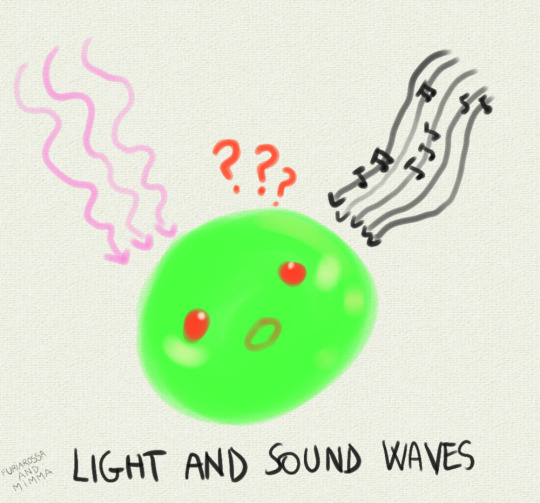
Interactions with sound
Uncoded ectoplasm
Uncoded ectoplasm tends not to react to sound waves in any way.
The sound wave does not transport matter, because the molecules remain where they are; instead it transports energy, that is the ability to set molecules in motion, making them vibrate up and down.
However, ectoplasm has an internal strength generally greater than that of sound waves: with highly mobile electrons, detached from their nuclei, whizzing at high speed and with very high motility within the material, ectoplasm is unpenetrable from "low" vibrations! The sound waves will therefore pass through the ectoplasm, if it has a low ionization, or will slide around it, if the ionization is high.
Uncoded ectoplasm, while not interacting with the sound waves around it, can actually make sounds! When hit with enough force (for example with a laser), the ectoplasm moves rapidly from regions of high density to more stagnant areas, those of lower density. The ectoplasm, which thickens in the transition zone between the regions of low and high density, generates a series of pressure pulses, i.e. sound waves.
With a frequency close to one trillion Hertz, the sound that is generated reaches the highest possible frequency for this type of material, approximately 6 million times higher than what can be heard by mammals. It is therefore impossible for a human being to hear the sound produced naturally by non-codified ectoplasm, since it only produces sounds with a frequency higher than 20,000 hertz, i.e. ultrasound, a category of sounds not perceptible to the human ear.
Coded ectoplasm
Spirits can communicate despite being composed of ectoplasm, simply by using electrical micro-discharges coming directly from their core: this is because plasma is mainly composed of ions that have their own mass and density. Since the density of the plasma is different from that of the cold air surrounding the discharge, by managing to modulate the power of the discharge, it is possible to move the boundary front between cold air and plasma.
By virtue of the difference in density, the movement of the air-plasma boundary causes a movement of the air itself and, consequently, the pressure waves responsible for the diffusion of sound originate.
In addition to being able to produce sounds, spirits can also interact with them, for example with the simple act of perceiving sound (hearing). This is because the core is able, by modifying the density of a specific area (such as the eardrums), to create structures capable of vibrating when hit by a sound wave.
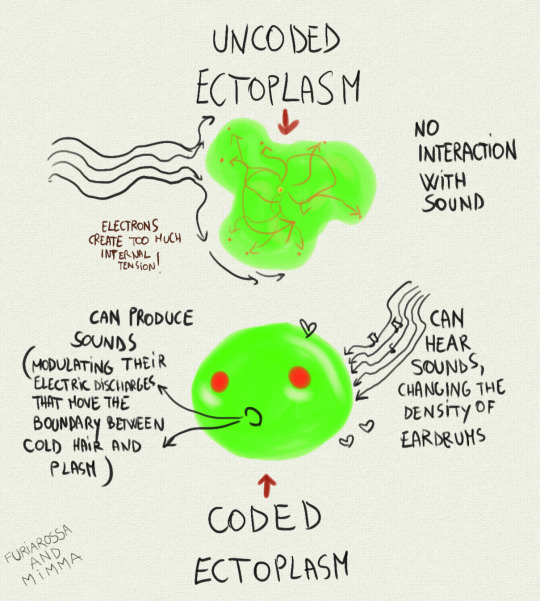
Interactions with light
Uncoded ectoplasm
The brightness of the non-coded ectoplasm is a good indicator of the time that has passed since its detachment from a living entity: the thin layer of phosphorus that covers it naturally tends to wear out if not renewed by the biological processes of the coded ectoplasm.
Uncoded ectoplasm also tends to have, over time, lower densities, which allow light to pass through transparently. Due to the internal excitation of the particles, the non-codified ectoplasm will still tend to emit some light, although it does not have the typical phosphorescent light: the "younger" one will have a more intense brightness, similar to that of a light bulb, while the "older" one, which has lost its viscosity, will appear noticeably duller and more transparent.
Coded ectoplasm
The coded ectoplasm is always covered with a thin layer of phosphorus, an element involved in the vital functions of all known life forms. Just like in humans, phosphorus accounts for approximately 1% of the body's weight.
Due to its very high reactivity, phosphorus is the ideal substance for covering a body with ectoplasm, supporting it to interact with the outside world, and it is precisely because of this thin layer, which is continuously hit by the plasma ions (as happens in a plasma television), that ectoplasm bodies are always surrounded by a luminous halo.
This phenomenon is called phosphorescence.

Invisibility
Spirits incarnated in an ectoplasmic body are capable of making their presence invisible to both humans and ghosts, and even to photoscanning devices (such as cameras); this occurs thanks to the controlled production of plasmons.
The plasmon is a quantum of plasma oscillations, that is, a quasiparticle resulting from the quantization of plasma oscillations, halfway between magnetic waves and particles. In particular, ectoplasmic entities exploit surface plasmons, i.e. plasmons localized near the surface of a solid, normally used (by humans) for the production of metamaterials.
Surface plasmons allow light to flow around an object, making it perfectly invisible.
Incarnated spirits also have the ability to make other people and objects invisible as long as they are in physical contact with them, extending their plasmon field.

Trivia
A luminous ectoplasm, in otpoelectronics, is also called a "phosphor", because they work like regular phosphors, by emitting light through their phosphorus coating properties!
Being covered in white phosphorus, the outer layer of the ectoplasmic bodies is poisonous to humans. Don't eat ghosts, kids!
--------------------------
And that's roughly what we think about how ghosts interact with light and sound! We hope it was enough, but... if you have any other question, maybe more specific... we would gladly, with joy, answer it!
And of course this applies to all of you! Help us build our lore with your questions!
All the ghost worldbuilding posts!
The "Ask us about ghost worldbuilding" post
Our ask is open!
#danny phantom#ghost worldbuilding#worldbuilding#danny phantom worldbuilding#fantasy world#fantasy worldbuilding#answered#answers#my danny phantom#ex novo the ghost#ex novo blobby#the way of legends#sci-fi
19 notes
·
View notes
Text
Popular Front for the Liberation of Palestine:
After failing to achieve any field accomplishments and its stark failure against the resistance, the zionist enemy commits war crimes in Beit Hanoun, attempting to depopulate it.
The Popular Front for the Liberation of Palestine confirms that the zionist enemy continues to commit new war crimes against Palestinian families and displaced persons in the city of Beit Hanoun in the north of the Strip, forcing thousands of displaced people in some shelters to flee the city amidst a wide campaign of arrests and mistreatment against hundreds of young people.
The Front asserts that what is happening is a new zionist attempt to forcibly empty the city of its people under the pressure of intense and heavy bombardment after failing its repeated attempts to displace our people there.
The Front considers that the defeated occupation made unarmed civilians and displaced persons direct targets as part of its vengeful policies after failing to achieve any field accomplishments and its inability to keep up with the resistance on the ground, which still commands, controls, and manages the battle skillfully and competently, continuing to launch rockets even from areas that the occupation has invaded by land, continuing to exhaust the occupation’s officers and destroy its vehicles and armor.
The Front holds the international community responsible for the continuation of the zionist war crimes of killing, displacement, starvation, and siege, and attempting to depopulate the northern governorate of its inhabitants.
The Front emphasizes that the international establishment has provided the zionist entity with all means of protection and immunity from prosecution and accountability, stating that "more than half a year has passed since these documented massacres were committed, yet the international institutions are still discussing and researching whether the zionist enemy is committing acts of genocide against the Strip or not? This once again proves the direct involvement of the international community in the genocide war and covering up war crimes, as if these crimes were committed elsewhere, international armies would be mobilized and this war would be stopped by force according to Chapter VII of the United Nations Charter."
The Front concluded its statement by affirming that all the occupation's crimes and plans aimed at displacement or depopulating the cities will fail and will shatter against the rock of the steadfastness, sacrifices, and resistance of our people.
The Popular Front for the Liberation of Palestine
Central Media Department
16-4-2024
8 notes
·
View notes
Note
If Aegon I really did prophecise the return of the Others (as HOTD claims), shouldn't he have tried to reform Westeros' military structure to prepare? A standing army might be too difficult to keep fed in a world with variable winters. However, in some medieval themed stories I've read there have been kingdoms with a "central band" that is always active, and is augmented by levies when a war actually occurs. Also, in your response to my last question you mentioned the possibility of making those eligible for military service train for a certain number of days every year.
I did mention that, but I also mentions that such a provision, even for a kingdom not as ridiculously huge as Westeros, would be laughably unenforceable. Even countries with greater bureaucratic organization, like Rome or Byzantium, struggled with mobilization and readiness - time spent doing drill is time not spent having a living. In later eras, governments tried all sorts of carrots and sticks to make sure there was at least some levels of training: everything from fines for people who did keep their kit in good order such as in the Asize of Arms to the Anglo-Saxon fyrdsmen being trained by the regions to act as a first line against raiding Vikings to militiamen getting free food and beer to show up for drill day in the Thirteen Colonies. Enforcement for these provisions was typically done at the local level simply because having a national-level system for doing so was simply not feasible. You could have a smaller organization have regular training, such as town watches which might be able to organize with the help of city-wide entities like burghers and guilds. So while that would be very smart, it is likely beyond Aegon's capacity.
There is an entity that can act like this, and in fact, is supposed to act like this: The Night's Watch. Regular tithes and donations to the Watch to help support cashflow problems that early armies would struggle with (hence why mercenary companies frequently turned brigand when there were no wars to sign up for), but it's simply not sufficient without regular payment. If Aegon wanted to support this in a way that was much more politically feasible - he'd mandate a percentage of taxes taken in be sent to the Night's Watch, or possible tax forgiveness up to a certain amount for donations to the Watch. This is a little bit easier to manage, as tax assessments could be made a little more regularly than unit inspections of far-flung regions and the Night's Watch can easily record donations received to help simplify the accounting process.
The fact that this isn't done, and that Aegon is smart enough to know this, is yet another indication that this "plot twist" is not integrated very well in the story. As I've said in the past, it feels like poorly-executed, tacked-on nonsense and significantly hurts Aegon's characterization, introducing a bunch of plot holes while addressing only one rather insignificant question regarding Aegon (why conquer Westeros?) that wasn't even all that important to begin with.
Thanks for the question, Ryu.
SomethingLikeALawyer, Hand of the King
17 notes
·
View notes
Text
A Handful Of Games I Played This Year
without major coverage that is
Neophyte
I've long since stopped trying to keep roguelites out of these lists because they are such a large part of the independent game scene and more importantly because no matter how much I stamp my feet and insist They're All The Same, I Do Keep Playing Them. So Neophyte is just that; a vampire survivors-esque roguelite where you're playin a little monk man.
You pick two spells/attacks at the start of the game and over the course of it gain stat bonuses, spell modifiers, defensive skills, ultimate skills, the works. It comes off as something of a combination of a roguelite, where you're building your character over the course of the run, with more of a vampire survivors gameplay loop where enemies spawn and you kill them. Kill all the enemies in a wave, get a set of prizes, repeat. It ends after... I want to say 9 - 12 waves, and if you win you get a prestige modifier that makes the next run harder. Simple. To be honest I think the game distills what a lot of people really liked about roguelites quite well, and it makes for a satisfying gameplay loop, if you're into that sort've thing.
Sorry We're Open
Sorry we're open is what I'm calling a corporate horror RPG where you play a manager of a retail chain. Over the course of a workday you encounter various paranormal entities with a slight retail twist, and using your party members (which are randomly generated and are capable of being replaced via hiring and firing), you beat em up. You use money from your job to use skills, and in the course of exploring the retail store you begin to unravel a bizzare eldritch corporate plot.
It all sounds more jokey then it is, and while I'd struggle to call it scary it kept my attention. In my opinion it ran a little long and the combat is a little loose with the amount of money it gives you so by the end of the game you're just spamming powerful skills and skipping combats and wondering why the combat is even in the game. The secret ending is a bit obnoxious too. That said I do think it tells a neat little story and while you're getting adjusted to the combat system it's quite satisfying. Made by the guy that made No Delivery, Oates, if you are familiar, another game I quite enjoyed.
Thunder Ray
Remember punch out? Super punch out maybe? This game isn't Exactly like that, and I wouldn't go in expecting Super Punch Out Two or anything, but it's a solid modern adaption. First person boxing game, you are Thunder Ray, world champion, who is abruptly abducted by aliens to compete in a galactic fighting tournament.
There's really not much more to say about it. If you're not familiar with punch out it's a first person boxing game where attacks must either be blocked or dodged and you gotta land punches and there's health bars and etc etc. Thunder ray is very similar to that, though it's a bit more heavy on the memorization and repitition of fights. It was apparently made by a mobile development team as a first effort at PC dev and it's quite good for a first timer! The visual style is fantastic and while it's not the longest game in the world I did enjoy working my way through it. More fights to come, evidently, as the story ends on a cliffhanger.
Escape from Terror City
Third person lightgun game. You will need a controller. You're a freedom fighter fighting an invasion force that's attempting to conquer a neutral planet that mines vital minerals for war efforts. While the developer of the game has invested much time into this setting and he has loads of games about it, I'm going to leave it at that. The plot isn't really a home run, and it's very formulaic, but I can't bring myself to bag on a guy that's making his own little personal worldbuilt setting that he made a website for and everything. Let's get to the actual game.
Third person lightgun game, so you're viewing the world from behind the player character. You will need a controller; I repeat myself for good reason, the game is God Awful on keyboard and mouse. You move your targeting reticule to select where you are shooting, hold A to shoot. Make your way through stages on rails, branching paths, five levels. Another simple one, reminsicent of old arcade lightgun games, though unlike beat-em-ups and shoot-em-ups, lightgun games never really got the cult following they did, so this is a bit of a rarity as far as I'm aware. I'm not gonna tell you the game is perfect, there's a bit of polish missing and the dialogue portraits range from passable to almost grotesque. But the majority of the graphical work in the game is solid, and while there's a few Weird Bits, I think it's a fun little romp. Again, not a long game.
The Stinger: Slightly more well covered games that I'm talking about anyway
Void Stranger
If you've been following this blog for any appreciable amount of time you know there was a period of time of about two months where I was religiously playing this game and it made me like chew my nails and bug my eyes out of my skull and everything. It's good! If you're into Sokoban (block pushing/tile replacement puzzles) with a dash of large scale overarching la-mulana esque puzzles. I stress the second part of that is not a massive part of the game; it is largely faithful to the sokoban genre.
Largely for the puzzle game player, I'd reccomend it more for the sokoban then the overarching puzzles (though if you can finish them and get past the puzzles in the main game there's quite an interesting little trail to follow there! I don't want to downplay that!), and if you're shooting for the large scale puzzles there's a few that make you take notes though, so I'd reccomend keeping some basic notes while you progress through the game. The story follows Gray, a lady in waiting for a king. I can't tell you anymore without spoiling anything. I've technically already spoiled you a little bit! The game does have a significant and compelling plot however, and I really enjoyed discovering it. There's not a part of this game that I don't whole heartedly reccomend outside of a few puzzles. I'd keep talking but I think I'd just sort've keep repeating myself and gushing about the game. Strongly Reccomended.
Do you remember why you're here?
Book of Hours
Another game I played a lot. You're an occult librarian maintaining an occult library. There's a lot to be said about the game world but the fun is in the discovery so I'll leave it at that.
It is quite literally a library management game and you do less handing books out then sorting your vast mansion of a library and studying eldrich secrets. Oddly comfortable, and not a game that pushes you very hard. If you're looking for something more along the lines of say, animal crossing, with a bit more of a Wizard flare then you can not go wrong with this. It's a solid bit of experimentation and I reccomend it. I can't even really talk about the mechanics very much because learning how things fit together is also a part of the charm. It's just sort've a charming wizardgame. I dunno.
Done
Get Out
7 notes
·
View notes